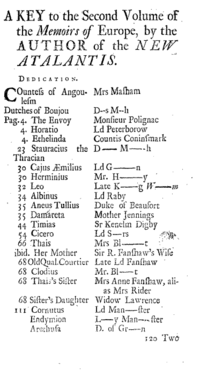Roman à clef
Roman à clef (French pronunciation: [ʁɔmɑ̃ a kle], anglicised as /roʊˌmɒn ə ˈkleɪ/),[1] French for novel with a key, is a novel about real life events that is overlaid with a façade of fiction.[2] The fictitious names in the novel represent real people, and the "key" is the relationship between the nonfiction and the fiction.[3] This metaphorical key may be produced separately—typically as an explicit guide to the text by the author—or implied, through the use of epigraphs or other literary techniques.[4]

Created by Madeleine de Scudéry in the 17th century to provide a forum for her thinly veiled fiction featuring political and public figures,[4] the roman à clef has since been used by writers including Sylvia Plath, John Banville, Truman Capote, Harold Robbins, Simone de Beauvoir, Ernest Hemingway, George Orwell, Jack Kerouac, Victor Hugo, Blaise Cendrars, Philip K. Dick, Bret Easton Ellis, Jay McInerney, Naguib Mahfouz, John McGahern, Charles Bukowski, Malachi Martin, Saul Bellow, Hunter S. Thompson, James Joyce, and Djuna Barnes.
The reasons an author might choose the roman à clef format include satire; writing about controversial topics and/or reporting inside information on scandals without giving rise to charges of libel; the opportunity to turn the tale the way the author would like it to have gone; the opportunity to portray personal, autobiographical experiences without having to expose the author as the subject; avoiding self-incrimination or incrimination of others that could be used as evidence in civil, criminal, or disciplinary proceedings; The ability to change the background and personalities of key participants; and the settling of scores.
Biographically inspired works have also appeared in other literary genres and art forms, notably the film à clef.
See also
Notes
- "Roman à clef - Definition and More from the Free Merriam-Webster Dictionary".
- "The Continuum Encyclopedia of American Literature", By Steven R. Serafin, Alfred Bendixen, Continuum International Publishing Group, 2005, ISBN 0-8264-1777-9, ISBN 978-0-8264-1777-0, p. 525
- "Cambridge paperback guide to literature in English" by Ian Ousby, Cambridge University Press, 1996
- The Modernist roman à clef and Cultural Secrets, or I Know That You Know That I Know That You Know" by M. Boyde, University of Wollongong, 2009
References
- Amos, William (1985). The Originals: Who's Really Who in Fiction. London: Cape. ISBN 0-7221-1069-3.
- Busby, Brian (2003). Character Parts: Who's Really Who in CanLit. Toronto: Knopf Canada. ISBN 0-676-97579-8.